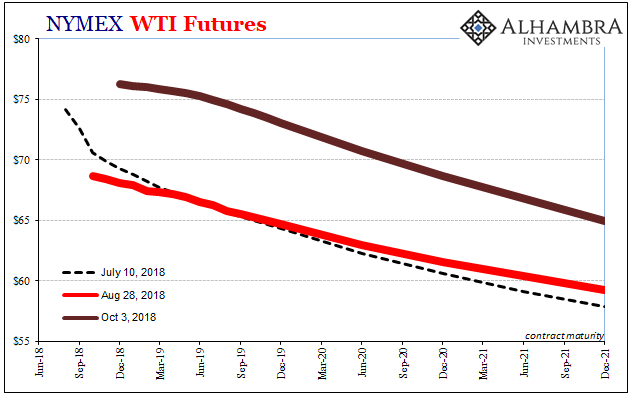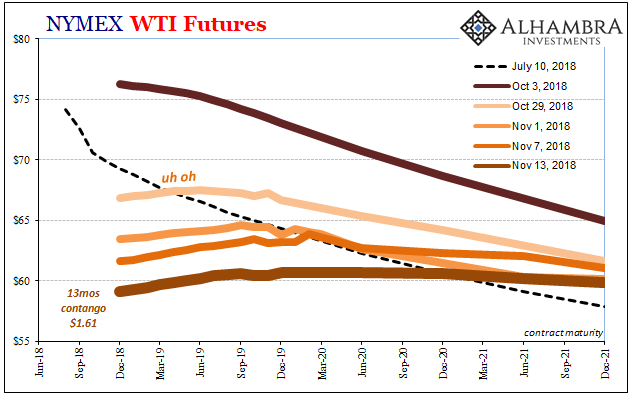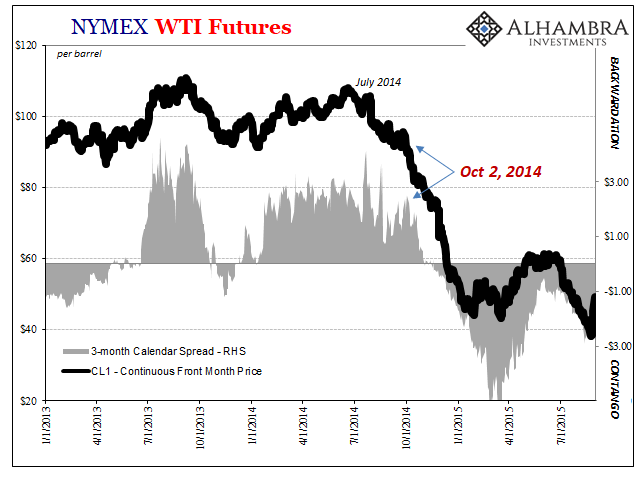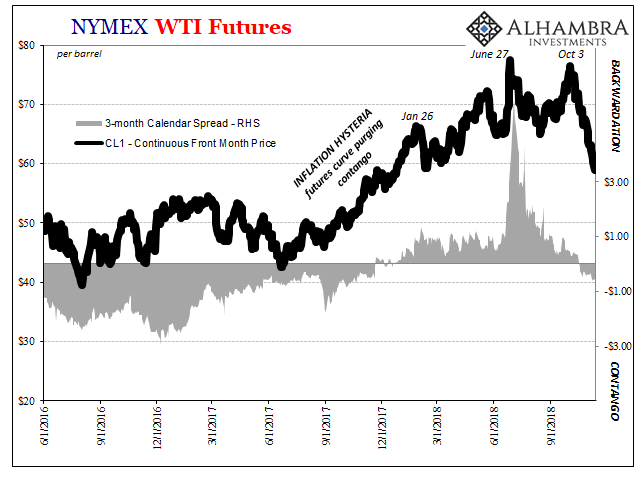Approaching The Point Of No Return?
At the end of June, the crude curve really got out of hand. WTI futures had returned to backwardation many months before, and then the eurodollar/collateral explosion May 29 sapped some crude strength. Over the following month, curve backwardation would become extreme as the benchmark price seemed ready to skyrocket.
After getting up near $80 a barrel, the price reversed. During the several weeks of weakness, the futures curve remained in steep backwardation – the expectation that the recovery (narrative) would continue whatever any short-term profit-taking.

But as prices did rebound through September, there was already trouble underlying. The curve was changing shape, flattening out even beyond normalizing that pretty ridiculous backwardation spike late June/early July.

WTI would nearly match its earlier high on October 3, by then the curve was already a little threatening becoming unlike its shape from July. Since that day, it’s been a steep incline down in price as the futures curve has shipped back into contango.

It has continued to flatten out at the back and “fish hook” at the front. These are quite concerning signs about perceived future imbalance in the oil markets. Those concerns are not altogether about the oil markets.
Of course, in the booming global economy of the mainstream, this is the product of success; too much success. The US is pumping out a record amount of oil and the rest of the world (OPEC) has started to normalize to $100 oil expectations. It’s another supply glut.
Stop me if you’ve heard this before. It should sound very familiar, too familiar. We need only go back four years for all the same general soundbites: the economy is booming, the energy sector is pumping record amounts, and WTI contango is the least of anyone’s concerns.
Obviously, it didn’t quite turn out that way which raises the interesting question as to whether the same mistakes will be repeated. I’d bet they will, right up until the bitter (cycle) end.
If we look at one very close calendar spread, say the 3-month, it can give us a sense of just how far this imbalance might have been running. This calendar spread is the difference in contract price between the front-month futures price, whatever happens, to be first on the board at any given time, and the one three months behind. If either contango or backwardation swings in the opposite direction at a 3-month interval, then that’s something to pay attention to.

This started to happen in October 2014. Oil prices had overall come down from highs in June, and the curve had flattened a little bit through September that year. Then early October.
You might remember those few weeks for other reasons, none of which had anything to do with US shale output. There were collateral disturbances in repo at the end of September 2014 and then the big, disruptive “buying panic” in UST’s on October 15. Global currency markets returned to life for all the wrong reasons, soon to make the disruptions of 2013 appear quaint and lovely by comparison.
When the oil curve started to reshape during that time, WTI (front month) was still ~$95 a barrel. On October 2, 2014, it had fallen to $91.02. Then as the futures market rethought the whole narrative the reappearance of contango would coincide with the oil market’s worst crash since the second half of 2008 (another period fraught with funding and dollar difficulties).
By the time the 3-month calendar spread reached $1 contango (the CL4 contract price $1 more than CL1, the front month) in mid-December, the oil price had dropped 38% from October 2 and was down 48% from the June high. Less than a month later, the 3-month spread was $2 contango with CL1 under $48.
A week after that, on January 15, 2015, the Swiss National Bank shocked the world by removing the franc’s peg to the euro. Though the dollar wasn’t directly involved in that effort, it was the reason for the trouble. I wrote the month before while contango was deepening about Switzerland’s setback:
In that respect, the SNB is now in the same kind of conundrum (in opposite directions) as the Banco do Brasil in trying to ward off a currency problem that is not its own. The “dollar” missteps in the past six months are too immense for any one central bank to address. That is the problem here as this is not just a run of “dollar” disorder, though that is the primary symptom and means of “contagion”, but rather the global financial system is in a state of high pessimism and contraction. With currency crises raging all across the planet, it is a desperate warning that too much financial imbalance is unsustainable for the given economic reality as measured against prior economic expectations.
I could have written the same thing yesterday, exchanging Switzerland (no longer pegged to the euro) for China and its RRR fight. The action in oil as eurodollars in December 2014 and January 2015 announced the arrival of the severe stuff. It was only the beginning of what was to come, but by the start of 2015, there was really no chance for things to go any other way. It was past the point of no return.
How close are we to something like that? Inching closer every day, perhaps right on the cusp. Janet Yellen would say throughout the time that these were just “transitory” factors that wouldn’t impede expected global economic acceleration. She spent the balance of 2016 regretting much. Jay Powell says the same thing, only he hasn’t used the word “transitory” yet. Eurodollar futures are guessing he will at some point.
Contango and currency. But supply glut or something.

Disclaimer: All data and information provided on this site is strictly the author’s opinion and does not constitute any financial, legal or other type of advice. GradMoney, nor Jennifer N. ...
more










